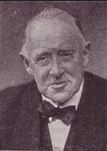
Christine's Picture Book (Danish : Christines Billedbog) is one of three famous scrapbooks created in part by the Danish author Hans Christian Andersen.

Christine's Picture Book (Danish : Christines Billedbog) is one of three famous scrapbooks created in part by the Danish author Hans Christian Andersen.
Hans Christian Andersen was a friend of the Danish Baron Henrik Stampe (b. 1821) and his wife Jonna Drewsen (b. 1827), as well as of Jonna's father, Adolph Drewson. [1] [2] He became godfather to their daughter Christine (30 October 1856 – 9 March 1884), who had been named for her paternal grandmother Christine Stampe (née Dalgas). [2]
Together, Andersen and Adolph Drewsen compiled a scrapbook for Christine's third birthday in 1859. [3] Its 122 pages contain over 1,000 pasted-in pictures, in some cases accompanied by hand-written captions or poems. [3] There are also a few paper cuts, an art form at which Andersen was adept. [3] The images were collected from all kinds of European publications, and the result offers a unique pictorial snapshot of European culture of the 1850s. [3] Similar books exist for Christine's sisters Astrid, who became a women's rights activist, and Rigmor, who married the composer Victor Bendix.
Inspired by the book, Christine's granddaughter-in-law Countess Alette Bardenfleth set up a foundation to support projects related to Danish history, literature, language, and music. The foundation published Danish, English, German, and Italian editions of Christine's Picture Book in 1984; a Swedish edition appeared the following year. [3] A documentary of the same title was made for Danish television in 1985. [4]
The book is now in the collection of the Silkeborg Kunstmuseum, which worked with the Royal Library of Copenhagen to create a digital edition of Christine’s Picture Book in 2005. [5]

The Royal Library in Copenhagen is the national library of Denmark and the university library of the University of Copenhagen. It is among the largest libraries in the world and the largest in the Nordic countries. In 2017, it merged with the State and University Library in Aarhus to form a combined national library. The combined library organisation is known as the Royal Danish Library.
The Modern Breakthrough is the common name of the strong movement of naturalism and debating literature of Scandinavia which replaced romanticism near the end of the 19th century.

The Royal Danish Academy of Sciences and Letters (Danish: Det Kongelige Danske Videnskabernes Selskab or is a Danish academy of science. The Royal Danish Academy was established on November 13, 1742, and was created with the purpose of strengthening the position of Science in Denmark as well as promoting interdisciplinary understanding.

Danish literature a subset of Scandinavian literature, stretches back to the Middle Ages. The earliest preserved texts from Denmark are runic inscriptions on memorial stones and other objects, some of which contain short poems in alliterative verse. In the late 12th century Saxo Grammaticus wrote Gesta Danorum. During the 16th century, the Lutheran Reformation came to Denmark. During this era, Christiern Pedersen translated the New Testament into Danish and Thomas Kingo composed hymns. Fine poetry was created in the early 17th century by Anders Arrebo (1587–1637). The challenges faced during Denmark's absolute monarchy in 1660 are chronicled in Jammersminde by Leonora Christina of the Blue Tower. Ludvig Holberg (1684–1754), influenced by the ideas of the Enlightenment and Humanism, is considered the founder of modern Danish and Norwegian literature. Neoclassical poetry, drama, and the essay flourished during the 18th century influenced by French and English trends. German influence is seen in the verse of the leading poets of the late 18th century such as Johannes Ewald and Jens Baggesen. Other 18th century writers include the hymn writer Hans Adolph Brorson and the satirical poet Johan Herman Wessel.

Copenhagen Jazz Festival is a jazz event every July in Copenhagen, the capital of Denmark. Copenhagen Jazz Festival was established in 1979, but beginning in 1964 Tivoli Gardens presented a series of concerts under the name Copenhagen Jazz Festival with Thelonious Monk, Miles Davis and many others.

This is a list of published works by Hans Christian Andersen. The list has been supplemented with a few important posthumous editions of his works; the year given in each entry refers to the first Danish edition. They are all in the public domain because Andersen died over 100 years ago.
The Royal Norwegian Society of Sciences and Letters is a Norwegian learned society based in Trondheim. It was founded in 1760 and is Norway's oldest scientific and scholarly institution. The society's Protector is King Harald V of Norway. Its membership consists of no more than 435 members elected for life among the country's most prominent scholars and scientists.

Børge Christian Jessen was a Danish mathematician best known for his work in analysis, specifically on the Riemann zeta function, and in geometry, specifically on Hilbert's third problem.

Nysø Manor, located near Præstø in the southeast of the Danish island of Sealand, was built in 1673 for Jens Lauridsen, a local functionary. It now houses the Thorvaldsen Collection, a group of works by the Danish sculptor Bertel Thorvaldsen, who lived and worked there in his later years.

Marianne Hoppe Grøndahl (1938–2012) was a Danish photographer. Trained in publicity and press photography, she worked in both the theatrical environment and as a documentary photographer, remembered for her images of Jordan.

Frederiksberg Ældre Kirkegård is a cemetery in Frederiksberg, Copenhagen. It was established in 1734 behind Frederiksberg Church.

Astrid Stampe Feddersen, usually known as Astrid Stampe, (1852–1930) was a Danish women's rights activist and author alongside her sister Rigmor Stampe Bendix. Stampe joined the women's movement early on and from 1883 to 1887, she was on the board of the Danish Women's Society, playing an active part in work on women's issues.

Vilhelm Rasmus Andreas Andersen was a Danish author, literary historian and intellectual, who primarily focused on the study of Danish literature. He was one of the first to use the term "Golden Age of Culture" to refer to the 1800s, and his focus on bringing Danish literature to the public earned him great popularity. Andersen was instrumental in the development of the School of Radio, as a means of disseminating public education to prevent loss of cultural identity and treasures.
Christinelund, originally a farm under Nysø Manor, is located a few kilometres east of central Præstø, on the island of Zealand's Jungshoved peninsula, in Vordingborg Municipality in southeastern Denmark. It takes its name from the salonist Christine Stampe and was frequently visited by Hans Christian Andersen in the 1850s, when it was the home of Henrik and Jonna Stampe. The current main building was completed in 1860 to a design by the architect Ferdinand Meldahl. It was listed on the Danish registry of protected buildings and places by the Danish Heritage Agency on 23 February 1978. The property is now operated as a bed and breakfast.

Christine Stampe, née Dalgas, was a Danish noblewoman known as one of the chief benefactors of the Danish/Icelandic sculptor Bertel Thorvaldsen.

The Danish Constituent Assembly is the name given to the 1848 Constitutional assembly at Christiansborg Palace in Copenhagen that approved the Danish Constitution and formalized the transition from absolute monarchy to constitutional democracy. It consisted of members of which 114 were elected by the people, 38 were appointed by the king and the rest were government ministers.

Rigmor Stampe Bendix (1850–1923) was a Danish baroness, writer and philanthropist. In 1898, she became editor of Kvindernes Blad, a supplement to various daily newspapers, developing it as an organ for the women's movement. She is remembered in Denmark for her biographies of the sculptor Bertel Thorvaldsen, Baronesse Stampes Erindringer om Thorvaldsen (1912) and of her godfather Hans Christian Andersen, H.C. Andersen og hans nærmeste Omgang (1918).

A Meeting in the Royal Danish Academy of Sciences and Letters is a monumental 1897 oil-on-canvas group portrait painting by Peder Severin Krøyer, depicting the membership of Royal Danish Academy of Sciences and Letters during one of its meetings in the Prince's Mansion in Copenhagen. The painting was commissioned by the Carlsberg Foundation in conjunction with the construction of its new building on H. C. Andersens Boulevard. Measuring 519.4 cm (204.5 in) wide and 266.7 cm (105.0 in) tall, it is Krøyer's largest painting.

Hof- og Stadsretten was a modern-style court of justice introduced in Denmark, specifically for Copenhagen, by Johann Friedrich Struensee in 1771. In 1805, it was merged with the new Landsoverret for Eastern Denmark as Den kongelige Landsoverret samt Hof- og Stadsret. It was replaced by the Københavns Byret and Østre Landsret in 1919.